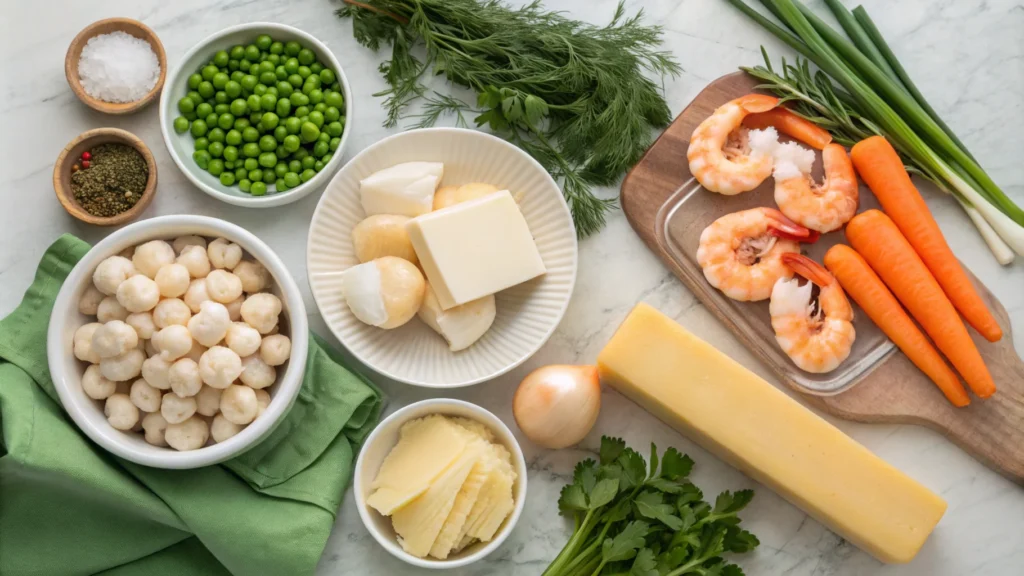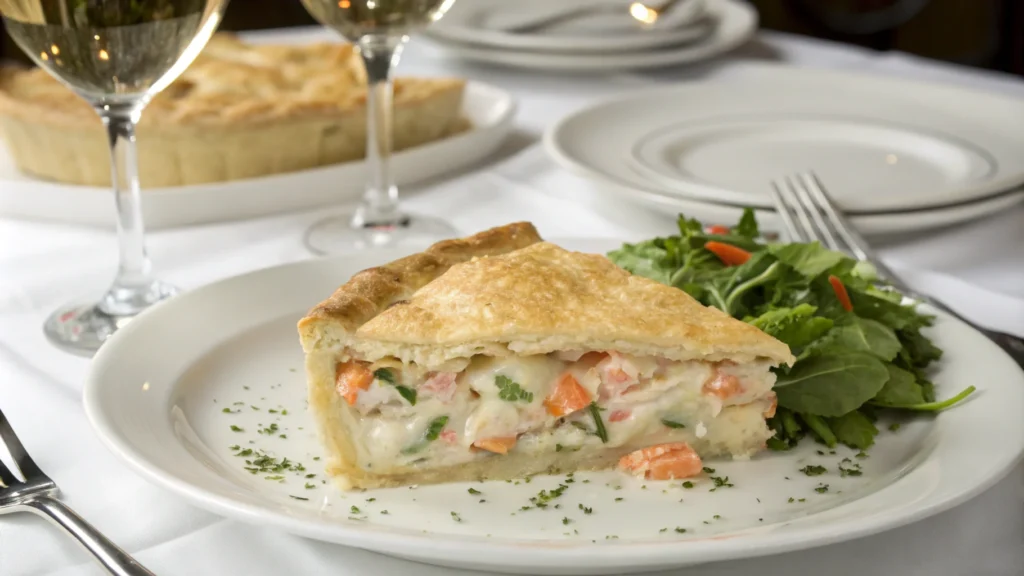When it comes to comfort food that blends gourmet flair with hearty satisfaction, few dishes can rival a well-made Seafood Pot Pie. With its flaky crust, creamy filling, and delightful mix of seafood and vegetables, this dish is a timeless favorite. This guide explores every aspect of creating the perfect Seafood Pot Pie, from its history to the step-by-step recipe.
What Is a Seafood Pot Pie?
A Seafood Pot Pie is a savory pie filled with a combination of fresh seafood, vegetables, and a rich, creamy sauce, all encased in a buttery, flaky pastry crust. This dish elevates the traditional pot pie by introducing seafood, which adds a luxurious and flavorful twist.
Whether served as a family dinner or a centerpiece for special occasions, this dish is versatile and deeply satisfying. Its unique combination of ingredients ensures a depth of flavor that caters to seafood lovers while offering the classic comfort of a pot pie.
Explore variations in seafood-rich dishes, like in this Crab Brûlée Recipe, for added inspiration.
The History and Origin of Pot Pies
The origins of pot pies can be traced back to ancient Rome, where savory pies were prepared using various meats and encased in pastry. These early pot pies often featured elaborate designs and were served at grand feasts.
Over time, the concept of pot pies spread across Europe, particularly in England, where they became a staple of comfort food. In America, pot pies evolved further, incorporating regional ingredients like chicken, beef, and seafood. The Seafood Pot Pie is a relatively modern adaptation, showcasing the abundance of fresh seafood in coastal areas and offering a luxurious alternative to traditional pot pies. The luxurious Chicken Pot Pie Crescent Rolls demonstrate how innovative adaptations continue to delight today.
Ingredients Needed for a Perfect Seafood Pot Pie

Creating a Seafood Pot Pie that strikes the right balance of flavors requires careful selection of ingredients. Each component plays a vital role in achieving the perfect taste and texture.
Essential Seafood Options
The heart of a Seafood Pot Pie lies in the seafood. Consider using:
- Shrimp: Adds sweetness and a firm texture.
- Scallops: Delicate and buttery, they melt in your mouth.
- Lump crab meat: Brings a touch of richness.
- White fish (like cod or haddock): Provides a mild, flaky element.
- Clams or mussels: Impart a briny depth of flavor.
When selecting seafood, ensure it is fresh to maximize the dish’s quality. Frozen seafood can be a substitute, but proper thawing is crucial.
Vegetables That Complement the Dish
The vegetables in a Seafood Pot Pie add color, texture, and nutrients. Ideal choices include:
- Peas: A classic choice for their sweetness.
- Carrots: Provide vibrant color and a subtle crunch.
- Celery: Adds a mild, earthy flavor.
- Corn kernels: Enhance the sweetness of the filling.
- Mushrooms: Offer a meaty texture and depth.
These vegetables not only balance the richness of the seafood but also enhance the overall flavor profile.
The Role of Creamy Sauces in Pot Pies
The creamy sauce is the backbone of a Seafood Pot Pie, binding the ingredients and adding a luscious texture. Common components of the sauce include:
- Butter and flour for a roux base.
- Milk, heavy cream, or a mix for richness.
- Seafood stock to infuse oceanic flavors.
- Herbs like thyme, parsley, and dill for aroma.
A well-made sauce ensures the filling remains moist without becoming overly dense, striking the perfect balance for every bite.
Tools and Equipment for Preparation
To prepare a flawless Seafood Pot Pie, the right tools are essential. Here’s what you’ll need:
- Rolling pin: For creating a uniform crust.
- Pie dish or baking dish: Provides the perfect vessel for baking.
- Sharp knife: For chopping vegetables and cutting pastry.
- Mixing bowls: Essential for preparing the crust and filling.
- Whisk: Ensures a smooth, lump-free sauce.
- Pastry brush: For applying egg wash to the crust.
Having these tools on hand makes the process smoother, ensuring the final dish turns out perfectly.
Step-by-Step Recipe for Seafood Pot Pie
Creating a Seafood Pot Pie involves several stages, but the effort is well worth it. Follow these steps to master the recipe.
Preparing the Crust
The crust is the first impression of your pie, so making it right is essential.
- Ingredients: Combine all-purpose flour, cold butter, a pinch of salt, and ice water.
- Method:
- Cut the butter into the flour until it resembles coarse crumbs.
- Gradually add ice water and mix until a dough forms.
- Wrap the dough in plastic wrap and refrigerate for at least 30 minutes.
- Rolling: Roll the dough on a floured surface to fit your pie dish, ensuring an even thickness.
A homemade crust is preferable, but store-bought options can save time in a pinch.
Cooking the Filling
The filling is where the magic happens, combining all the elements of the Seafood Pot Pie.
- Prepare vegetables: Chop carrots, celery, and mushrooms into small, uniform pieces.
- Cook seafood: Sauté shrimp and scallops until just cooked, then set aside.
- Make the sauce:
- In a skillet, melt butter and whisk in flour to create a roux.
- Gradually add seafood stock and cream, stirring constantly.
- Add cooked vegetables, seafood, and season with salt, pepper, and herbs.
The sauce should be thick but pourable, enveloping the seafood and vegetables evenly.
Assembling the Pot Pie
Bringing everything together is the final step.
- Layer the filling: Pour the prepared filling into the pie dish.
- Top with crust: Carefully place the rolled-out crust over the filling, trimming the edges.
- Seal and decorate: Crimp the edges to seal and make small slits in the crust for ventilation.
- Bake: Preheat the oven to 375°F (190°C) and bake for 30-40 minutes, or until the crust is golden brown.
For a creative spin, explore tips from Chicken with Peanut Butter Recipe, showcasing how sauces can transform classic flavors.
Variations and Substitutions
When preparing a Seafood Pot Pie, there’s plenty of room for creativity and customization to cater to dietary preferences or ingredient availability. Below are popular variations and substitutions that can transform this classic dish.
Gluten-Free Seafood Pot Pie
Creating a gluten-free Seafood Pot Pie requires replacing traditional ingredients like flour and pastry with gluten-free alternatives.
- Crust substitutes: Use gluten-free flour blends or almond flour to make the pastry crust. Pre-made gluten-free pastry dough is also an option.
- Thickening agents: Replace all-purpose flour in the creamy sauce with cornstarch or a gluten-free flour mix.
- Bread crumbs: For a textured topping, gluten-free bread crumbs can be used instead of a crust.
These substitutions ensure that the dish retains its signature taste and texture while accommodating dietary restrictions.
Dairy-Free Options
For a dairy-free Seafood Pot Pie, the creamy filling can be modified without compromising flavor:
- Milk substitutes: Use unsweetened almond milk, oat milk, or coconut milk as a base for the sauce.
- Butter alternatives: Swap butter for plant-based options like vegan margarine or coconut oil.
- Cheese replacements: Omit cheese or use dairy-free cheese substitutes.
With these simple adjustments, you can enjoy the creamy richness of the dish without any dairy ingredients.
Vegan and Vegetarian Alternatives
Although seafood is the star of this dish, vegan or vegetarian versions can offer equally delightful results:
- Seafood substitutes: Use plant-based seafood alternatives or replace seafood with hearty vegetables like mushrooms, artichokes, or zucchini.
- Sauce base: Combine vegetable stock and plant-based milk for the sauce, and enhance it with nutritional yeast for a cheesy flavor.
- Crust adjustments: Ensure the crust is made without butter or eggs by using vegan pastry recipes.
These variations are ideal for those seeking a plant-based twist on the classic Seafood Pot Pie.
Tips for Achieving the Perfect Pot Pie
To create the ideal Seafood Pot Pie, attention to detail is crucial. Here are some expert tips to elevate your dish:
- Keep the crust cold: A chilled pastry ensures a flaky texture.
- Don’t overcook the seafood: Slightly undercook the seafood before baking to avoid rubbery textures.
- Season generously: Balance the richness of the sauce with salt, pepper, and fresh herbs.
- Use fresh ingredients: Fresh seafood and vegetables yield the best flavor and texture.
- Let it cool: Allow the pie to rest for a few minutes after baking to help the filling set.
Following these tips guarantees a pot pie that is both visually appealing and delicious.
Serving Suggestions and Pairings

A Seafood Pot Pie is a hearty dish that pairs beautifully with various side dishes and beverages. Consider the following ideas:
- Sides:
- A crisp green salad with vinaigrette.
- Roasted asparagus or steamed broccoli.
- Crusty bread or garlic toast.
- Beverages:
- A chilled white wine, such as Sauvignon Blanc or Chardonnay.
- A light beer or sparkling water with lemon.
These accompaniments add balance and contrast, enhancing the overall dining experience.
Nutritional Benefits of a Seafood Pot Pie
A well-prepared Seafood Pot Pie offers several nutritional advantages:
- Protein-rich: Seafood like shrimp, scallops, and fish provide high-quality protein.
- Omega-3 fatty acids: Essential fatty acids from seafood support heart and brain health.
- Vegetable nutrients: Carrots, peas, and celery contribute vitamins and antioxidants.
- Calcium and vitamin D: Dairy-based sauces boost calcium and vitamin D intake (for non-dairy versions, fortified milk substitutes can provide these nutrients).
While rich and indulgent, this dish can also be part of a balanced diet, especially when paired with wholesome sides.
Common Mistakes to Avoid
Avoiding these common pitfalls ensures a successful Seafood Pot Pie every time:
- Soggy crust: Prevent this by blind baking the bottom crust or using a top crust only.
- Overcooked seafood: Add seafood to the filling just before assembling to avoid overcooking during baking.
- Runny filling: Use the right ratio of roux to liquid, and cook the sauce until thickened before assembling.
- Over-seasoning: Be cautious with salt, especially if using seafood stock or salted butter.
These mistakes can compromise the dish’s texture and flavor, so a little extra care goes a long way.
FAQs About Seafood Pot Pie
What is pot pie made of?
Pot pie typically consists of a savory filling made with meat or seafood, vegetables, and a creamy sauce, encased in a pastry crust.
What is the difference between hotpot and pie?
A hotpot is a stew cooked and served in a single pot, while a pie includes a pastry crust and is baked.
What is fish pie sauce made of?
Fish pie sauce usually combines butter, flour, milk, or cream, and seafood stock, seasoned with herbs and spices.
Why do you not use a bottom crust on chicken pot pie?
A bottom crust can become soggy due to the moisture in the filling, so many recipes opt for a top crust only.
Are pot pies English?
Yes, pot pies have origins in English cuisine but are now popular worldwide with various regional adaptations.
Can pot pies be healthy?
Yes, pot pies can be healthy when made with lean proteins, plenty of vegetables, and controlled amounts of fat in the crust and sauce.
Conclusion
A Seafood Pot Pie is a versatile and satisfying dish that blends rich flavors, creamy textures, and a buttery crust into a culinary masterpiece. Whether you’re experimenting with variations like gluten-free or vegan options, or sticking to the classic recipe, there’s something for everyone to enjoy. With the right techniques, tips, and pairings, this dish becomes a perfect choice for comfort food enthusiasts and seafood lovers alike.


3 thoughts on “Mastering the Art of Seafood Pot Pie: A Complete Guide”